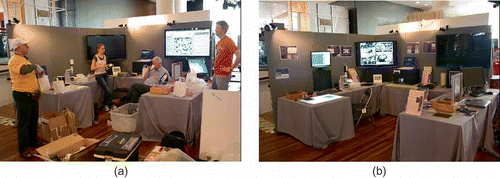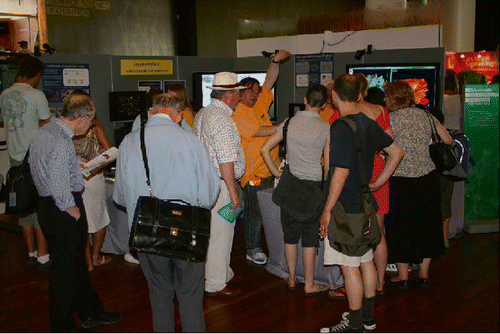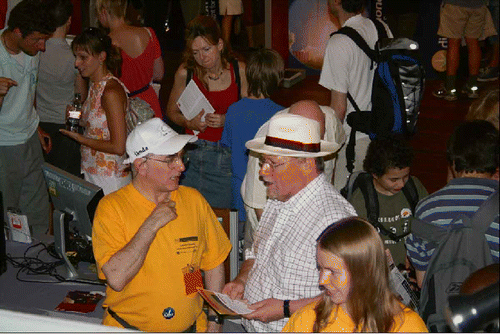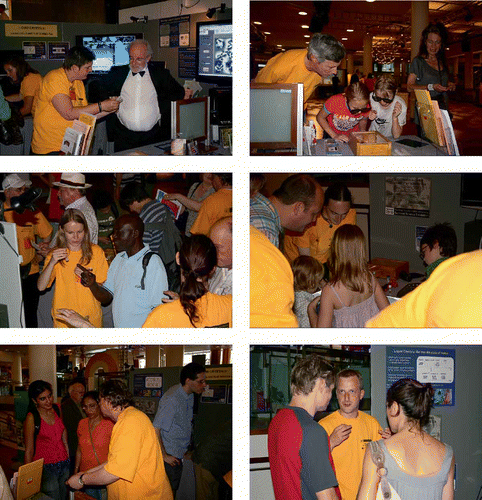The 2010 Royal Society Summer Science Exhibition
The year 2010 marks the 350th anniversary of the Royal Society, one of the oldest learned societies worldwide. One of the highlights of the celebrations was the Summer Science Exhibition, which was held in London at the Southbank Centre from 25 June to 4 July.
This was probably the biggest public engagement event of the year in the United Kingdom, if not worldwide, and the topic of liquid crystals was chosen to be represented by ‘Liquid crystals: living cells and flat screen TVs’, among 31 booths from all aspects of science, research and technology. The stand and information material was designed by a group of researchers from the Universities of Manchester, Southampton, Sheffield Hallam and York, with the active involvement of Ingo Dierking, Helen Gleeson, Tim Sluckin, David Dunmur, Doug Cleaver, Verena Görtz and John Goodby (http://seefurtherfestival.org/exhibition).
The public, ranging from school children, families and teachers all the way to academics, peers, and all the Fellows of the Royal Society, were invited to view the latest about liquid crystal research, ask questions, and be entertained by hands-on experiments. We introduced the topic from its basics, with simple experiments on birefringence, and liquid crystal to liquid phase transitions, and showed the beauty of liquid crystal textures. The magic of selectively reflecting beetles and temperature sensitive sheets was very popular, as was the strength of Kevlar fibres and the bullet proof vests. Novel three-dimensional (3D) laptops that work without any glasses, and dual vision SatNav systems, where the driver is taken along the map, while the passenger can simultaneously watch a movie on the same screen (both provided by Sharp Laboratories of Europe) were both high up on the list of the visitors coming to the stand ().
Figure 1. It may look like a picnic in the park (a), but pulling together an exhibit (b) for such a vast number of visitors from different backgrounds does actually require some thought, planning and logistics.

One of our first visitors at the stand was in fact Her Majesty, The Queen. Indeed our exhibit was the first that she visited after the official ceremony. Obviously, she is always at the pulse of time. She was soon to be followed by the Duke of Edinburgh, and also Universities Minister David Willetts. It was interesting to also have Helen Sharman for discussion, the first Briton in space. Attentive television viewers will also have made out Tim Sluckin and myself on our brief appearance on national BBC television on Newsnight. Just to avoid any possible misunderstandings: Tim was the one with the funny hat.
From basic science and research, all the way to high-tech applications, the general public loved it, and an estimated 30,000 people visited the 2010 Royal Society Summer Science Exhibition. Personally, I spent much of the duration of the event in London (), and I believe that about 10,000 people must have actively been engaged with our exhibition, made some experiments, and talked to a member of staff manning the stand. This was a fantastic opportunity to promote liquid crystal research.
Figure 2. It may not immediately be clear, but I am in fact explaining the selective reflection of circularly polarised light exhibited by some beetles.

At this point I also have to draw attention to all the student and postdoctoral helpers (and of course their supervisors that supported their attendance), who so readily gave up their time to tell the public about liquid crystals and possibly also their own research, because it is important to demonstrate that liquid crystals is much more than just flat panel screens. We had about 20 additional voluntary helpers from liquid crystal groups all over the United Kingdom: Gavin Alexander (Bristol), Emily Bevis (York), Charlotte Borgers (Sharp Laboratories of Europe), Stephen Cowling (York), Keith Daly (Southampton), Eddie Davis (York), Robert Greasty (Bristol), Philip Hands (Cambridge), Sharon Jewell (Exeter), Richard Mandle (York), Steve Myers (Hull), Benjamin Outram (Oxford), Nina Podoliak (Southampton), Ranjith Rajasekharan (Cambridge), Dave Stewart (York) and BaiJia Tang (Hull). It was brilliant to see how engaged everyone was, and how enthusiastically everyone promoted our field of research. Thanks a lot to all of them. Without their help, we would have not been able to run this event, simply because of the vast number of visitors ().
Figure 3. An estimated number of 10,000 visitors came to our stand to learn about liquid crystals, their properties and their applications. Tim Sluckin is trying hard to convince the other guy with a hat, that there really is so much more to liquid crystals than just flat panel displays.

It really was great fun … and OK, it also was a lot of work, organisationally, logistically, long hours, and temperatures that actually challenged our heat-sensitive sheets, which went up to 30°C (). However, considering the response of the public, it was definitely worth it. I would do it again, and I am sure that everybody else involved would do so too.
Figure 4. The stand really was a 12 hours per day activity over nearly two weeks. It was simply overwhelming to experience the response of the public, and to see how interested everyone was in the science of liquid crystals.

And in fact, we will. In March 2011 we will run a three-day session at an event known as ‘The Big Bang’, also in London, for an expected 10,000 visitors from secondary schools.
Finally, it has of course to be mentioned that an exhibition like this does not come cheap. I thus would sincerely like to acknowledge the respective funding, which was provided by the Engineering & Physical Sciences Research Council (EPSRC), The University of Manchester, Sheffield Hallam University, the University of Southampton, The British Liquid Crystal Society, SHARP Laboratories of Europe, Linkam, Fujifilms and Oxford University Press. Without the money, we could not have done it.
Now, we can look back at a very successful event to bring liquid crystals into the awareness of the general public, to show that liquid crystals are so much more than the highly successful liquid crystal displays, and we can plan the next big event in March 2011. Quite obviously, our previous exhibition has struck the imagination of the public, and I am very happy to organise similar events in the future.
Ingo Dierking
School of Physics & Astronomy
University of Manchester, UK